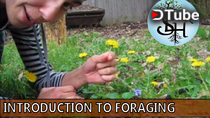
Spring is upon us! That means that there will be a whole host of edible wild plants to be enjoyed. And it doesn't matter if you are in the city or in the country, wild foods can be found just about everywhere. Certainly everyone is near an abundance of foods - you just need to have the eyes to see!
In our old city backyard, we were able to harvest dandelion, black walnuts, mulberries, and stinging nettle. Now that we are on our acreage, there is even more to find! We had a late start last year as we moved here in June, but we are excited about the prospect of spring this year and all the medicinal and edible plants that it brings.
So, if you are interested in this sort of thing, join Michelle as she gives a general introduction to to world of foraging.
Happy eating!
▶️ DTube
▶️ IPFS
Thanks for the video. I would say that my number one rule when out gathering greens for home consumption, is never ever gather, pick or eat anything within 20 yards of a street that has blacktop o n it. Reason being that the exhaust from the vehicles does contain poisons, like you mentioned, And if you are not on a dirt road, the exhaust spreads when it hits the blacktop. The dirt road rule I use is 10 yards. If you live in a rural area where the traffic is just the occasional car, you can make your adjustments, but remember blacktop is always a 20 yard rule for me.
Second if I am out hiking or just for a walk I always have a camera. Take a snapshot of the plant, if you are unfamiliar with it, and you can always google image search it. You can also take a small sample of the most notable part of the plant or the entire plant. I also always keep ziplocks with me just in case.
Third, I always smell it. I find that the most interesting of plants tend to smell different. Some of the more stinky plants tend to have a very specific highly medicinal use, I find. The more pleasant smelling plants also tend to have unique properties.
You are absolutely right never eat anything unless you are sure what it is.
Great vid and post, I think I might join you and do a hike and forage, while I am out take lots of pics and do a write up!
Thanks for such a thorough and helpful comment! That is an excellent tip to add to the list. When we lived in our Cityhouse in Ohio (before the move to our homestead), we were warned about the lead content in our area---not in the 100 year old house paint, but the lead content along the street from the decades of leaded gasoline that had traveled up and down the road over the years.
Samuel Thayer also recommends sniffing bulbs, too! All of the allium (onion) family is edible, and the stinky/delicious odor of a garlicky or oniony bulb is a giveaway that it is safe and good to eat.
Welcome to Steemit, by the way! We just followed you. :)
Nice video. I think it's time to break out my Peterson Field Guide.
Do it! I have been scoping out all the tiny sprouts covering the ground with a hungry eye, excited to finally get some real greens back on our dinner table. Let us know what you find out there!
Nice intro! You're right; dandelion is the easiest and safest. I even hear it can be fermented ;)
As for walking through the woods and grappling with bears: once upon a time, my dad was offered a bear sandwich. He didn't bite.
I've never had dandelion wine, but it's not for lack of interest! It's probably my favorite wild food (though wild spinach/goosefoot is certainly a contender for that title).
A bear...sandwich? Can't say that I've ever heard of that before!
You should spend some time in backwoods Ontario. :)
lol... mmmmm dandy-wine
Great introduction to foraging!
The Daily Sneak.Thanks to @ecoinstant, this post was resteemed and highlighted in today's edition of
Thank you for your efforts to create quality content!